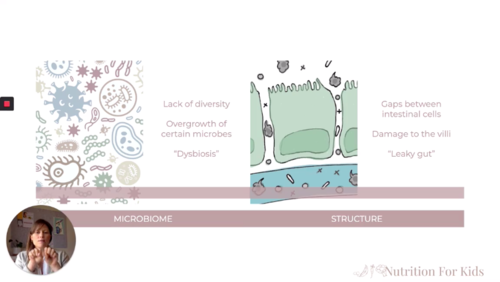Choosing your child's probiotic
Are you choosing the right probiotic for your child?
Probiotic supplements are not all created equal. In fact, there are vast differences between kids probiotics with some offering a therapeutic benefit and others being a huge waste of money.
Gut health awareness has skyrocketed over the last couple of years and we're now understanding how good bacteria balance and strong diversity can help enhance our children's health and wellbeing.
The amount of probiotic supplements available has increased as a result of this growth in knowledge about the benefits of probiotics.
However, often there is confusion about the types of probiotic supplements. When I speak to parents about gut health and the connection with their child's digestive health, immune system or skin complaints, for example, I'm often met with the comment "But, I have them on a kids probiotic".
With such varying differences between the supplements, what's the best probiotic for your child?
What strain will help provide the best support for your child's digestive system and relieve their constipation? What probiotic strains can help improve symptoms such as colic, reflux or bloating?
Should my 10-year-old be having a different probiotic supplement than my toddler?
These are all questions to consider when choosing the best probiotic for your child. Unfortunately, it's not as simple as one size fits all.
The probiotic strains are key
The specific strains in kids probiotic supplements differ greatly. You'll find many supplements will have a variety of Lactobacillus and Bifidobacterium species some limited to just one or two strains, others with several.
I like to think about probiotic strains like animals. Stick with me on this one! As you know there are a variety of animals, so you could consider Lactobacillus as dogs and Bifidobacterium as cats, for example. Now, there are heaps of different dog and cat breeds right? So Lactobacillus rhamnosus GG might be a labrador and Lactobacillus acidophilus LA5, a poodle.
Each of these dog different breeds has its own characteristics and personality, right? Likewise, the therapeutic actions, properties and characteristics of probiotic strains can differ significantly between strains.
For example, to promote general digestive tract healing and reduce inflammation after your child's had diarrhoea, probiotics containing Lactobacillus rhamnosus GG and Saccharomyces cerevisiae var boulardii Biocodex may be beneficial.
Probiotic supplementation with Lactobacillus reuteri, on the other hand, has been found to be beneficial for children with constipation.
If you neglect to pay attention to the specific strains in the kids probiotic, you may not be able to gain the health benefits you desire, and as such, be wasting your money.
If you are looking for an all-rounder and just for general health support, choose a probiotic supplement with a wide range of different strains.
Speaking to a trained health practitioner can help you determine which are the best probiotic strains for your child based on their health complaints.
DISCOVER the state of your child’s gut health
Take the Kids Gut Health Check-up quiz today to see how you can best support your child's health by healing and nourishing the gut.
Take the Kids Gut Health Quiz now.
The numbers of the probiotic strains matter
When choosing your child's probiotic, considering the amount of each strain is important. On most supplements, you’ll see numbers listed on the probiotic supplement as colony-forming units (CFUs).
Most research suggests the minimum quantity of bacteria needed to generate therapeutic effects is 109. So you need to think billions when selecting a supplement.
Some of the gummies and chewable probiotics targeted at kids or packaged probiotic foods like bars you'll find in the supermarket, simply don't have a high enough dosage to gain any health benefits.
For infants, the dosage should be 5-10 billion CFU per day. For children over the age of 2, the desired dosage should be 10-25 billion CFU per day.
New Evidence!
New evidence suggests BLB or viable live bacteria is actually a better indication of the bacteria population in the supplement. New technology is enabling supplement manufacturers to distinguish between live bacteria and those that are damaged or dead. This achieves a much better strain count.
For chronic health issues, accuracy is particularly important as your child may need more of a specific strain to can any health benefits.
Considering your child's age is important
As mentioned above, your child's age will affect the number of BLB or colony-forming units of the beneficial bacteria.
Why does age matter?
An infant's gut microbiome is very vulnerable and lacks diversity compared to adults. It's estimated young babies have approximately 10 different species whereas an adult has over 1000 species. A baby's microbiome born vaginally is predominantly made up of Bifidobacterium species versus an adult's microbiome which is dominated by Lactobacillus species.
After the age of 2, the child's gut microbiome composition resembles that of an adult and is much more stable.
As a result, you'll want a probiotic supplement that contains a higher dosage of beneficial bacteria in children over the age of 2. And, you won't necessarily need to be limited to just kids’ specific products and brands.
If you're breastfeeding, you may also want to assess your own gut health as bacteria will be transferred from the intestines to your baby's through your breastmilk.
Food can be a great source of specific strains
Many parents forget to consider probiotic strains that can be included in the child's diet to enhance gut bacteria diversity. Not only are there some great probiotic reach foods containing live cultures such as yoghurt, sauerkraut and kimchi, but they can also help improve colonisation.
If you're choosing a probiotic supplement to provide general support for your child's immune health or digestive function, for example, it's worth focusing on foods first.
The key to introducing probiotic foods to your child is to start low and go slow to reduce any unpleasant side effects such as bloating and flatulence. Start with half a teaspoon every second day and slowly build up from there. To increase bacteria diversity and encourage a healthy gut environment, include a selection of different probiotic foods into your child's diet and don't forget about prebiotics (more about prebiotics in an upcoming post).
Want to learn more about kids gut health?
The Kids Gut Health Webinar provides you with an introduction to the gut microbiome.
Over 49 minutes, nutritionist Sarah Appleford discusses what gut health actually means, the gut microbiome and what occurs in an unhealthy gut.
Watch the Kids Gut Health Webinar here.







